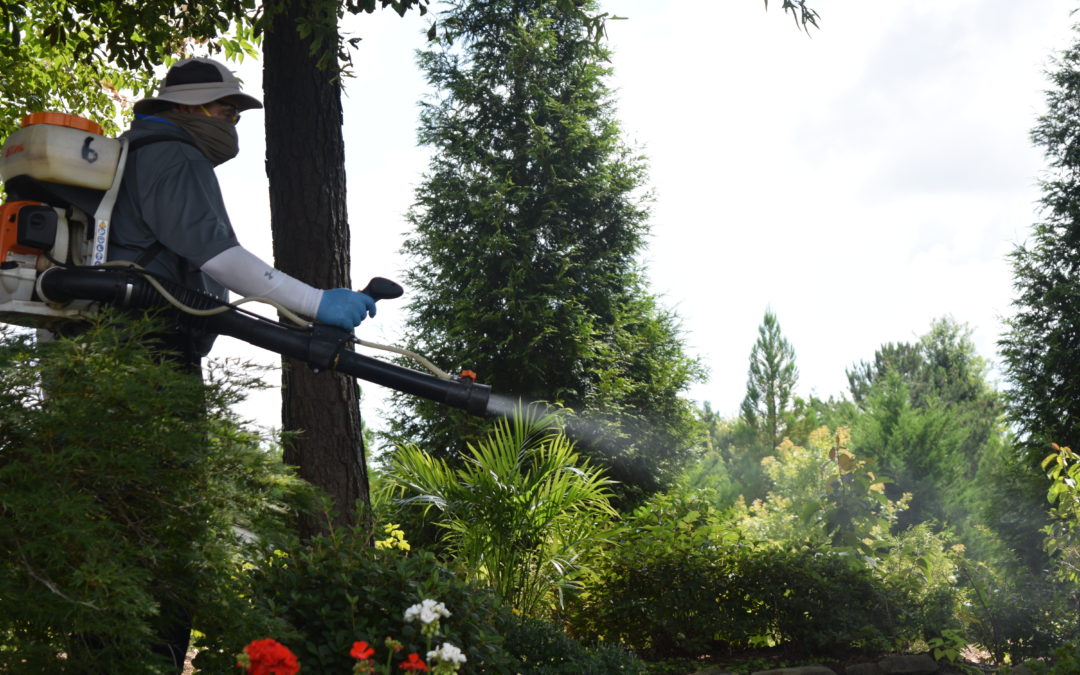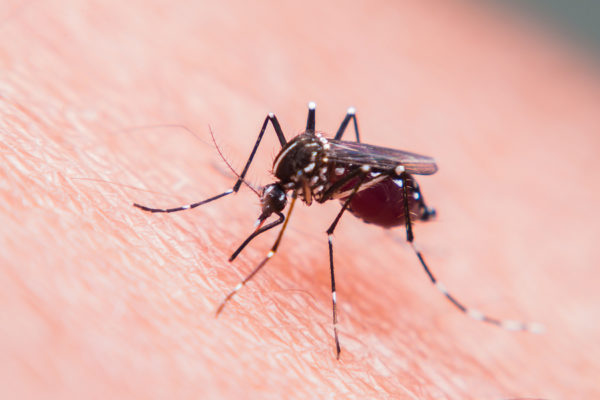
Mar 12, 2021 | Going Green, Mosquito
Mosquito season is right around the corner! Heat and humidity during these months combine to provide an ideal environment for mosquitoes to thrive. The season usually starts in the spring and peaks over the summer. Besides leaving behind itchy, red welts, these nuisance pests are dangerous to humans by vectoring serious diseases like Zika virus, West Nile virus, and chikungunya. Fortunately, there are several green pest control options you can utilize as an eco-friendly alternative to control mosquitoes. Here are 3 steps you can take for green mosquito control.
Identify Nesting and Resting Sites
The first step to controlling mosquitoes is identifying and eliminating what attracts them in the first place. Mosquitoes will come around in search of two things: nesting sites and resting sites.
Where do mosquitoes breed? Every species of mosquito lays its eggs in water. While the type of water source may vary between species, it only takes a minute amount of water for mosquitoes to hatch and develop. Get rid of any potential breeding sites by:
- Cleaning up debris around your home. Moisture can accumulate under piles of leaves, boards, mulch, rocks, and other outdoor items.
- Walking around your yard and identify any items that can hold water – pots, cans, bird baths, lids, toys, and planters. Empty them or store them upside down when not in use.
- Inspecting your gutters for clogs and keep them cleaned out. Watch out for sagging gutters or low spots where the water can accumulate.
- Repairing any poor drainage sites in your yard as these can lead to standing water. Consider leveling your yard or installing a french drain.
Once mature, adult mosquitoes will often rest in shady areas that are protected from the wind. Some common resting sites include trees, shrubs, potted plants, patios, and front entryways.
Protect Yourself From Bites
Any time you can protect yourself from mosquito bites you should. Prevent mosquito bites by:
- Blowing them away. Any breeze above 1 mph will make it difficult for mosquitoes to fly. If you have to spend time outdoors, consider using fans, whether battery powered, plug in or ceiling. Try to keep the air flow from the fans pointed at the lower half of your body as mosquitoes tend to fly closer to the ground to avoid said wind.
- Avoiding peak mosquito hours. Mosquitoes tend to feed at dawn and dusk as the wind typically dissipates around these times. Try to stay indoors during these times, especially during the warmer months.
- Applying insect repellent before going outdoors. When applying repellent, spray it onto your hands and rub it onto your skin rather than spraying it directly onto the skin. Repellents with DEET block the mosquitoes’ CO2 receptors, making them especially effective.
- If you are opposed to DEET, there are other natural mosquito repellents you can use instead.
- Picaridin is CDC approved and the most broadly used repellent outside the United States.
- IR 3535 is CDC approved and also repels deer ticks.
- 2-undecanone is CDC approved and is found naturally in cloves.
- Oil of lemon eucalyptus is CDC approved and has been proven in studies to repel as well as DEET.
- Avon Skin so Soft was shown in a 2015 study to repel mosquitoes for up to 2 hours.
- Permethrin fabric spray can be used on clothes, shoes, tents, and netting.
- Essential oils containing eucalyptus, rosemary, cloves, basil, and peppermint have also been shown to repel mosquitoes and are even used in many commercial products.
- Covering up when outdoors. Wear tightly woven, light colored clothing. The synthetic fibers in athletic wear are especially good at repelling mosquitoes. Dark colors stand out to mosquitoes, while lighter colors are less attractive.
- Considering the use of plants that repel mosquitoes around your home such as citronella, lavender, lemongrass, marigolds, and basil.
Applying Green Mosquito Treatments
Yards and climates vary across the region so the effectiveness and longevity of mosquito treatments will vary from home to home. Regardless of where you live or what kind of home you have, a green mosquito control program can be effective at helping control mosquito populations. Green mosquito control utilizes eco-friendly products that are just as effective as traditional products.
A complete green reduction program includes monthly mosquito treatments during mosquito season. Green treatments use products that are derived from flowers and botanicals and area only applied to the areas where they are needed instead of over the entire yard. They are effective at reducing both adult and larvae populations.
The green mosquito reduction program includes an inspection to identify resting and nesting sites; larvacide and adulticides to target all aspects of the population; source reduction and elimination by removing any areas of standing water; and a service guarantee where they will come back between treatments if needed, usually at no cost.
If you have a problem with mosquitoes or any other pests, contact a professional pest control company who can provide you with a thorough inspection and the most up to date traditional pest control and green treatment options available for you.
You May Also Be Interested In:
Termites: Prevent Before They Infest!
When Is Millipede Season?
Spring Cleaning to Keep Pests Out
Is There A Cockroach Season?
Orb Weaver Spiders: Dangerous or Not?

Feb 21, 2018 | Mosquito, Pest Control
The best approach to controlling mosquitoes takes advantage of every life stage of a mosquito. This approach is known as an Integrated Pest Management approach (IPM). IPM employs a variety of different pest management techniques with an emphasis on pest prevention, pest reduction, and the elimination of habitats that can lead to pest infestations. A successful IPM strategy is made up of 4 different strategies:
- Removal Of Habitats. Mosquitoes require a water habitat for 2 stages of their life cycle. Elimination of water leaves them with nowhere to breed. Get rid of any standing water in gutters, buckets, toys, old tires, tarps, and any other container in and around your home. Consider installing gutter guards to prevent standing water in your gutter systems. Empty and change out the water in your fountains, bird baths, rain barrels, wading pools, and potted plants at least once a week. This will get rid of any eggs that may have been laid in the water since emptying it the week before. Make sure to keep your swimming pools treated and circulating.
- Use Structural Barriers. Using structural barriers decreases the incidence of mosquito bites. Install screens on your windows and doors and make sure they are in good repair. Make sure the edges are sealed. Cover any gaps in walls, doors, and windows.
- Control Adult Mosquitoes. This is the best and fastest method to prevent diseases transmitted by adult mosquitoes. Adult mosquito control uses an EPA-registered pesticide and is applied by aircraft or on the ground by truck-mounted sprayers.
- Control Larval Mosquitoes. Controlling mosquitoes in the larval stage allows them to be eliminated before they emerge as adult mosquitoes. This involves a method called source reduction (also known as physical or permanent mosquito control). Source reduction is the removal or permanent destruction of mosquito breeding sites. The goal of source reduction is to minimize larval mosquito production through habitat destruction. It can minimize or completely eliminate the need for multiple applications of both larvacides and adulticides. Source reduction can be as simple as properly disposing of containers that can hold water or as complex as draining swamps or installing ditches. Some methods of source reduction you can do at home include disposing of, covering, or tipping over any containers that can hold water such as flowerpots, cans, and old tires. Source reduction for freshwater lakes and ponds include periodic drainage, minimizing emergent or standing vegetation, and maintaining steep banks. Source reduction for swamps and marshes is difficult because of severe restrictions in environmental law.
If you suspect you have a problem with mosquitoes in or around your home, contact a professional pest control company who can provide you with a thorough inspection and comprehensive treatment plan.

